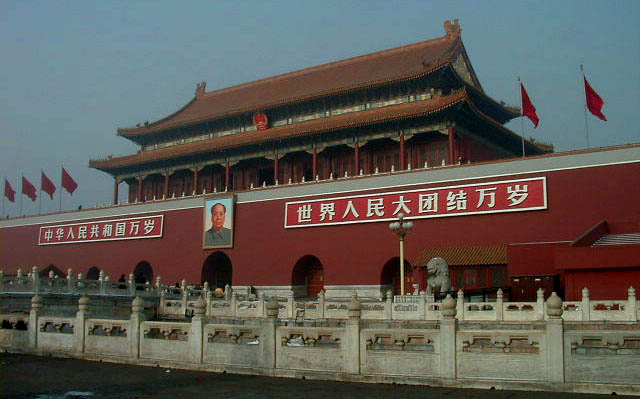

A picture of Mao Zedong still hangs at the entrance of the Forbidden City. After reading two books Chris gave to us about the recent history of China, Wild Swans and Daughter Of China, we are surprised the dictator's portrait still looks down on the Chinese and the city's visitors. A few people who lived in communist China under its founder Mao and beyond have recently published their painful experiences, allowing the world to learn about the tragic life and death of generations. Mao's abuse of power, crazy government programs and destructive pursuit of the class enemy cost the lives of millions of people, and almost eliminated all traces of China's ancient history. Fortunately, some of Mao's more thoughtful officials saved many of Beijing's ancient treasures from the Cultural Revolution.
Since the crazy dictator's death the government has realized the importance of preserving China's historical monuments. We were pleased to find the locations we visited in good condition. After strolling across monumental Tienanmen Square we entered the impressive gates of the Forbidden City. The seemingly endless complex of halls, temples, private quarters and assembly buildings is divided by enormous courtyards, white marble terraces and stairways, and massive walls with ornate entrance gates. The buildings include huge red wooden columns, intricately painted ceilings and beams, and carved window shutters, and are covered with glazed tile roofs. The temples house ornate offering altars in front of a singular, larger-than-life golden buddha statue. Other temple buildings exhibit a variety of saints, buddha figures and heroes along the walls. We would find this architectural style throughout the other temple and palace facilities we visited during the week.
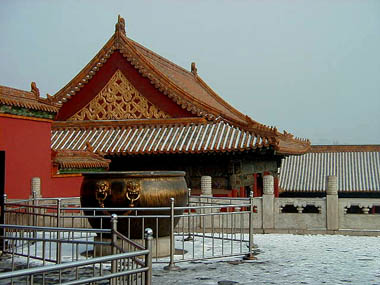
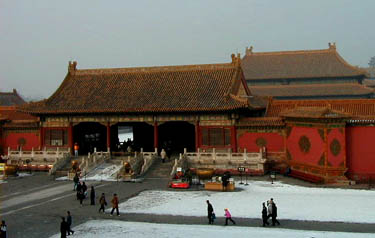
Decorated
Roofs, water bowl, wall with Gate in the Forbidden City
The temples and buildings within the Beihai Garden are set around a sizable lake. We were especially impressed by an app. 900 feet long roofed colonnade that curved around a small island and the white pagoda on top of the island's hill. The exterior walls of a small temple (picture left) next to the pagoda are covered with glazed tiles, each "housing" a small ceramic buddha figure. The roof detail (right) shows the typical parade of animals, led by the man on the hen, on each tiled roof corner. The figures protect the house from bad elements.
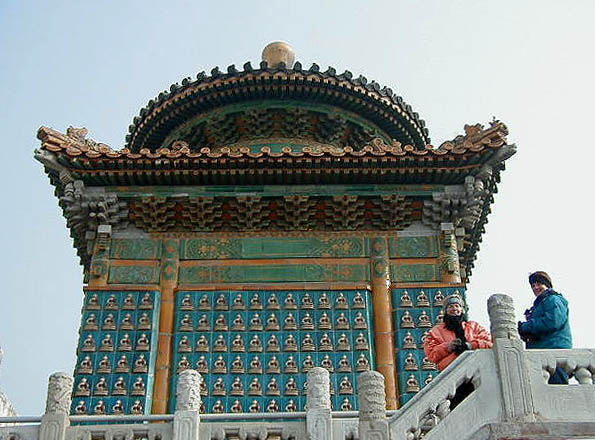
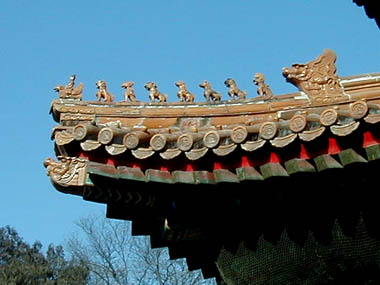
Beihai
Temple With richly decorated double Roof
We spent a full day discovering the grounds of the Summer Palace. This complex of private buildings, pavilions, temples and amusement quarters, used only by the emperor and his family, is situated on Kunming Lake. The impressive main temple (picture left) was built on top of a man-made hill and is surrounded by beautiful gardens. A path crosses the shallow lake and leads across seven different bridges. This steep marble "leap" is certainly the most impressive example.
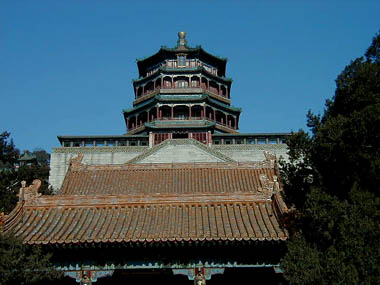
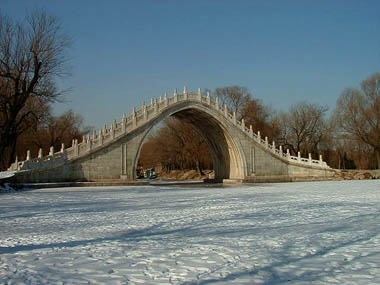
Summer
palace
The equally enormous grounds of the Temple of Heaven provided another full day of spectacular impressions. Many structures within the complex are round, including the marvelous main temple (picture right). A high marble road connects the various ceremonial buildings and halls. The emperor was always carried in a sedan chair from one ritual to the next. The cypress parks around the temples hide the emperor's study halls, sleeping areas, and rooms he used during a period of cleansing and abstinence. Elegant pavilions (left) provide shade for today's visitors.
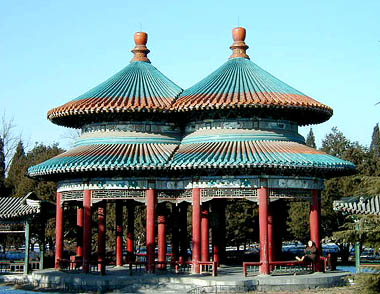
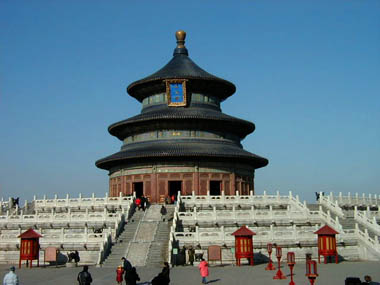
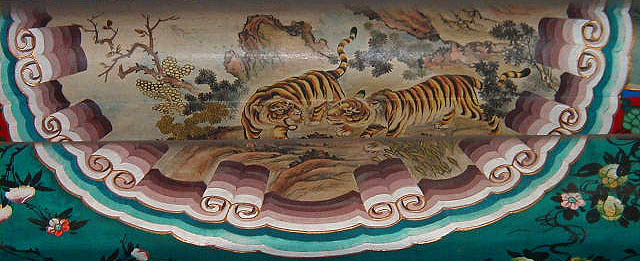
Ornamental
painting on a wooden beam
A region called Simatai, eighty miles northeast of Beijing in the mountain range separating China from Mongolia, was recommended as the most stunning, picturesque and remote place to see the Great Wall. The inexpensive taxi ride took us through a number of small towns and villages, allowing us a glimpse of rural life in China. Along the road side, whole fish, large hares and pheasants hung from makeshift stands fashioned from small tree limbs. The hunters sat around small fires waiting for an opportunity to make a sale. At the Great Wall site entrance we were greeted like dignitaries by an entourage of Chinese women. They managed to speak bits of English to welcome us and determine our origins. Once the formalities were complete the sales onslaught began. We explained to them clearly and pleasantly that we weren't buying anything. They refused to comprehend these phrases and followed along during our hike trying to sell us postcards, books and refreshments.
Twenty seven guard towers are connected by the three- to ten-foot-wide wall across the mountain ridge at Simatai. I hiked to seven of them, Chris and Elke climbed two and four respectively. Time pressure, cold temperatures, wind, and steep stairs covered with ice and snow kept us from going further. By the time we returned to Chris waiting at the second tower, she had bought a book. The women pressured us to buy another: "You buy book, you buy book!" Only after we bought a postcard collection the women agreed to leave. Later we looked at the book, filled with beautiful pictures of the wall at many locations and in different seasons, and regretted not buying one.
We never imagined visiting the Great Wall of China. Its construction was a feat of human achievement and endurance matched by few others. Standing on this magnificent structure, 4500 miles long, watching it serpentine across the distant mountains like a giant snake was one of the most elevating moments in our life. The pictures convey a minimalist version of our view and feelings.
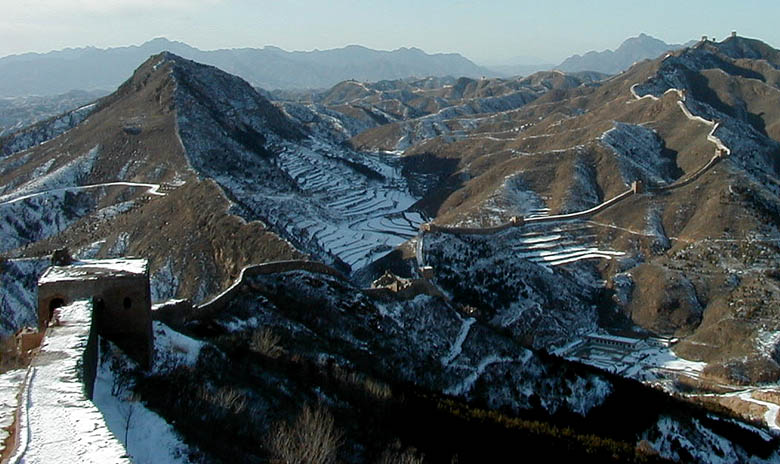

the great wall balances on the steep, narrow ridge at simatai
Eight days in China's capital gave us just enough time to explore some of the most famous sights. We had not expected such a rich collection of ancient monuments within the city and suburbs of Beijing. Our visit not only introduced us to the rich cultural heritage of this ancient country, but allowed us a glimpse of current living conditions in China. The majority of the population still lives in third world conditions. Whole families share the tiny, muddy rooms in walled communities within the city. The more recent residential constructions may include central heat and running water, but still look shabby and dirty. Garbage covers the streets. Coal burning and thick traffic create air pollution you can taste.
The streets are filled with thousands of bicycles, transporting people, coal, furniture, food and other goods even in freezing temperatures. But China is heading in new directions. Beijing's main boulevards start to resemble any other modern city. Large new hotels, shopping centers, high-rise bank buildings and international companies have brought Western goods, money and thoughts to the Chinese people. Visitors are now allowed to freely walk the city streets and even drive to the countryside. With the availability of information, alternative philosophies and professional opportunities, China's masses should strive to create a new nation. We left China with optimistic feelings, hoping that this country and its people have learned from past mistakes and suffering and will build a future without fear and oppression. And will remove and destroy Mao's image!